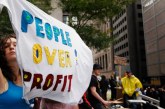Public Money Creation over Private Money Creation
Private Banks created 97% of UK’s £2.2 trillion money supply that was in circulation at the time of the financial crash of 2008.
Following the crash the Bank of England implemented a massive program of Quantitative Easing to rescue the banking industry. This newly ‘publicly’ created money could have been used differently.
Positive Money, the movement campaigning for a fair, democratic and sustainable money system states “More and more people are joining Positive Money to critique the Bank of England’s current £375 billion Quantitative Easing (QE) programme and call for an alternative.
This has prompted newfound interest in unconventional monetary policy proposals, also known as ‘Helicopter Money’, ‘Overt Monetary Finance’ (OMF), ‘Strategic QE’, ‘Green QE’, ‘Green Infrastructure QE’, ‘People’s QE’ and ‘Sovereign Money Creation’ (SMC).
All of the alternative QE proposals advocate the proactive creation of central bank money to stimulate growth in the real economy. Therefore, Positive Money collectively refers to these proposals as ‘Public Money Creation’.
The emergence of Public Money Creation proposals shows that there are a number of different ways that the Bank of England can create money to boost economic growth. Each proposals will have different implications for the economy.”
Jeremy Corbyn has pledged “Full employment and an economy that works for all”. This includes investing £500 billion in infrastructure, manufacturing and new industries backed up by a publicly-owned National Investment Bank and regional banks we will build a high skilled, high tech, low carbon economy that ends austerity and in the high speed broadband, energy, transport and homes that the country needs and allow good businesses to thrive, and support a new generation of co-operative enterprises.
Based on the state of the economy, Public Money Creation could be ONE of the many tools that could be considered to generate the necessary funds to these investments.






Pingback: The Magic Money Tree – Stuck in the Muddle
You keep saying this:
“.. Private Banks created 97% of UK’s £2.2 trillion money supply that was in circulation at the time of the financial crash of 2008… ”
But it’s not true, and you even contradict yourselves in another article here.
The Gov ‘debt’ (accumulated deficits) provides ‘money in circulation’. Even if it is aggregated and swapped into savings deposits like Gov Bonds, it is the same ‘money’ as regards aggregates.
Gov merely accommodates the Non-Gov sector savings desires. Net savings are still ‘money in circulation’ – balances owned by the Non-Gov sector. It’s disingenuous to suggest otherwise.
Saying that 97% of the money supply is bank credit, is simply not true. For the majority of the non finance sector (ie near all citizens and businesses), their savings are perfectly liquid.
Money flows in and out of retail savings instruments, where the excess reserves aggregate from, all the time.
In the US, after netting out the ‘debt’ Gov owes to other Gov depts. in internal accounting, the split of outstanding credit to reserves plus bonds, which make up the real money supply in circulation, is roughly 50/50,
Not even close to 97/3 %
Errors like this don’t inspire confidence in your proposals when you misrepresent facts in this way.
Private banks did create 97% of the money supply. Please check following reference as well.
https://www.ft.com/content/7f000b18-ca44-11e3-bb92-00144feabdc0
http://positivemoney.org/how-money-works/proof-that-banks-create-money/